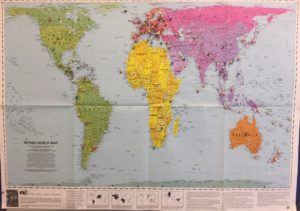Nobody sends them any more, but I thought I would write you a postcard from Malin Head. You know, just a few sentences scribbled on the back of a piece of card, saying “I wish you were here”, and reporting on the weather.
Talking of weather reports, “Shannon, Rockall, Malin, Hebrides, Bailey” is a familiar sequence from the iconic ‘Shipping Forecast’, broadcast on BBC Radio 4 to tell ships about the constantly changing weather conditions around the coasts of the British Isles. Ironically, despite the warnings of dangerous gales at sea, the reassuring authority of the broadcast has a calming effect on those of us well away from the oceans, safe on land, sheltered in our homes. Each sea area has a name and the weather forecast is spoken steadily for each of them, in clockwise order. Its inclusion in the Shipping Forecast is no doubt part of the reason I was attracted to visit Malin Head.
After working for a week in the Republic of Ireland, with creative businesses in County Donegal, I had some free time. On previous visits I had taken the opportunity to explore this most north westerly of Irish counties, driving to the small towns of Killybegs, Kilcar and Carrick, and walking high on the sea cliffs at Slieve League (Irish: Sliabh Liag). An extra day or two meant that I could combine my work with my travel addiction and explore the county of my new colleagues and friends, in the country of my grandparents. This time I would head north to Inishowen, where Lough Swilly meets the North Atlantic, going all the way to the most northerly point on the island of Ireland, on the very edge of Europe: Malin Head.
This place is an important point on the map, significant because of its geography. On this corner of the wild Atlantic coast you will find the old Malin Head Signal Station. Now it’s broken and derelict; technological archaeology from a past era before satellite communication, a reminder that continents once communicated with each other directly with radio signals skimming low across the vast water and over the horizon. This was the portal for signals with North America, built on the closest piece of land to that faraway continent. Nowadays there remain only the desolate remnants of buildings from a past century, unattractive concrete blocks, yet fascinating in what they represent. Gazing over the Atlantic Ocean, I reflected that we now have greater global communication power in our smartphones than this establishment ever had.
The modern coastguard station is only a short distance away, but out of sight from the Signal Station. Yet it’s visible, no doubt, to the seabirds flying in the gusty winds above. This is a haven for birds. The green grass at the cliff edges must be a welcome sight for geese and other feathered migrants arriving from across the Atlantic, a natural airfield with facilities for landing, eating and sleeping. For them at least, this is a truly friction-less border, without visa requirements or immigration controls.
On the same green margin of this island are huge letters, written boldly with white stones, spelling out the message “80 EIRE”. Designed to be visible from aircraft during World War 2, the Irish word EIRE indicated that this was neutral Ireland. In effect, those six characters were written to shout loudly upwards: “Don’t bomb here, go further East!”. I had heard of this sign before but didn’t know what the 80 signified. “Each one has a number,” my landlady told me, and went on to explain that similar signs were made all around the coast of the neutral State. Many of them survive and this one has been repainted as a national monument.
I had first arrived at Malin Head as light was fading and drove my car up to the Signal Station, silhouetted cold against the evening sky. It was February and the windy weather brought warnings of imminent rain, always a threat here. “Good, occasionally moderate, rain later,” as they say in the Shipping Forecast. Later, I found a warm pub to eat home-made food and drink a glass of Guinness, before walking in the blackness under a starless sky to my room at Serendipity Bed & Breakfast. I was the only guest in the modernised and tastefully decorated cottage. The following morning I went for a run, back up to the Signal Station, then further around the coast road, arriving back at my cosy guest house in time for a hot shower before breakfast.
As a special local treat, in addition to the traditional Irish breakfast, my landlady served me a milk pudding made with Carrageen Moss, a seaweed used as an alternative to gelatine to thicken the milky liquid, which is also enriched with eggs and flavoured with vanilla. Delicious.
Well, this postcard has become longer than I intended. Because I have endless digital paper I don’t have to force my writing to become smaller and smaller then creep up and around the edges of a card, finally squeezing into the last remaining space the usual final words of good wishes and farewell. And perhaps an ‘x’.
Copyright © David Parrish 2018.
Read more travel blogs and David’s travelling lifestyle business.
